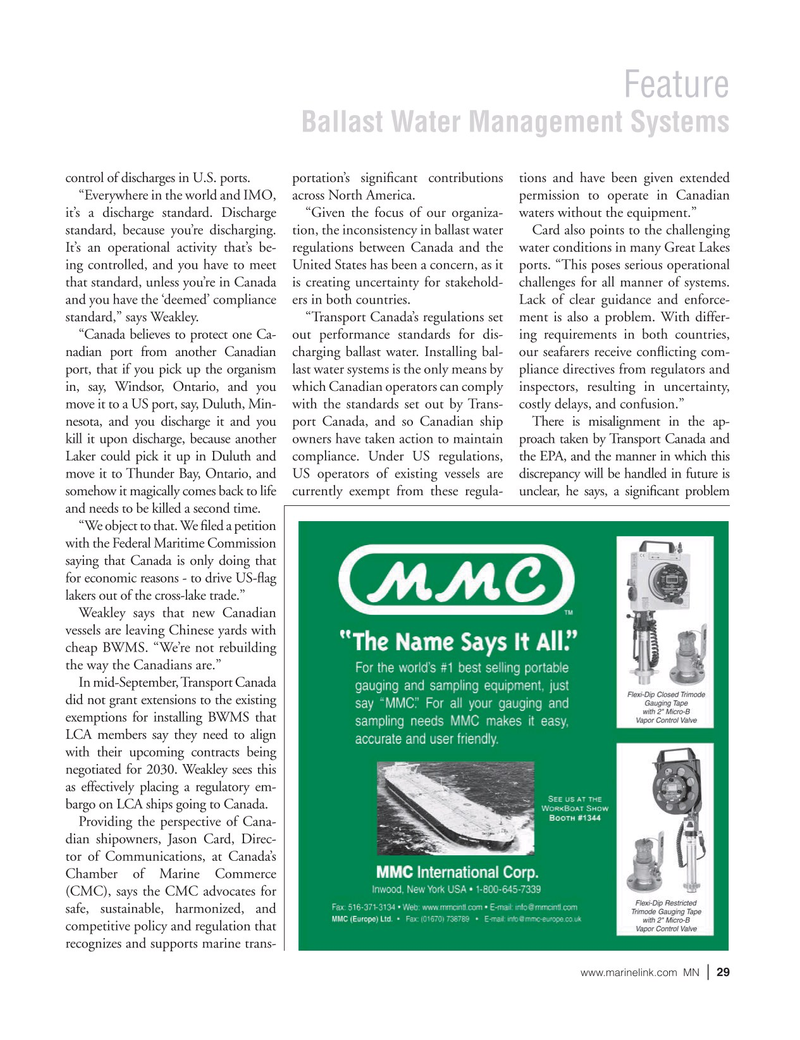
Page 29: of Marine News Magazine (November 2025)
Read this page in Pdf, Flash or Html5 edition of November 2025 Marine News Magazine
Feature
Ballast Water Management Systems control of discharges in U.S. ports. portation’s signi? cant contributions tions and have been given extended “Everywhere in the world and IMO, across North America. permission to operate in Canadian it’s a discharge standard. Discharge “Given the focus of our organiza- waters without the equipment.” standard, because you’re discharging. tion, the inconsistency in ballast water Card also points to the challenging
It’s an operational activity that’s be- regulations between Canada and the water conditions in many Great Lakes ing controlled, and you have to meet United States has been a concern, as it ports. “This poses serious operational that standard, unless you’re in Canada is creating uncertainty for stakehold- challenges for all manner of systems. and you have the ‘deemed’ compliance ers in both countries. Lack of clear guidance and enforce- standard,” says Weakley. “Transport Canada’s regulations set ment is also a problem. With differ- “Canada believes to protect one Ca- out performance standards for dis- ing requirements in both countries, nadian port from another Canadian charging ballast water. Installing bal- our seafarers receive con? icting com- port, that if you pick up the organism last water systems is the only means by pliance directives from regulators and in, say, Windsor, Ontario, and you which Canadian operators can comply inspectors, resulting in uncertainty, move it to a US port, say, Duluth, Min- with the standards set out by Trans- costly delays, and confusion.” nesota, and you discharge it and you port Canada, and so Canadian ship There is misalignment in the ap- kill it upon discharge, because another owners have taken action to maintain proach taken by Transport Canada and
Laker could pick it up in Duluth and compliance. Under US regulations, the EPA, and the manner in which this move it to Thunder Bay, Ontario, and US operators of existing vessels are discrepancy will be handled in future is somehow it magically comes back to life currently exempt from these regula- unclear, he says, a signi? cant problem and needs to be killed a second time.
“We object to that. We ? led a petition with the Federal Maritime Commission saying that Canada is only doing that for economic reasons - to drive US-? ag lakers out of the cross-lake trade.”
Weakley says that new Canadian vessels are leaving Chinese yards with cheap BWMS. “We’re not rebuilding the way the Canadians are.”
In mid-September, Transport Canada did not grant extensions to the existing exemptions for installing BWMS that
LCA members say they need to align with their upcoming contracts being negotiated for 2030. Weakley sees this as effectively placing a regulatory em- bargo on LCA ships going to Canada.
Providing the perspective of Cana- dian shipowners, Jason Card, Direc- tor of Communications, at Canada’s
Chamber of Marine Commerce (CMC), says the CMC advocates for safe, sustainable, harmonized, and competitive policy and regulation that recognizes and supports marine trans- www.marinelink.com MN 29|

 28
28

 30
30
